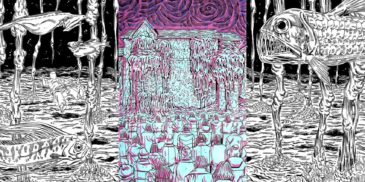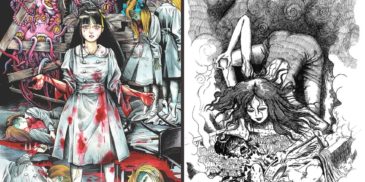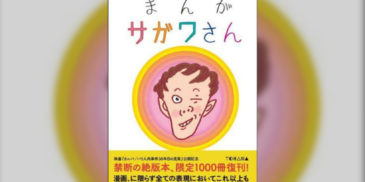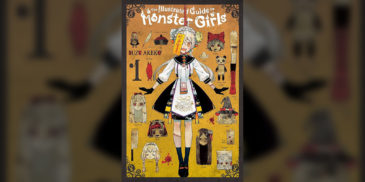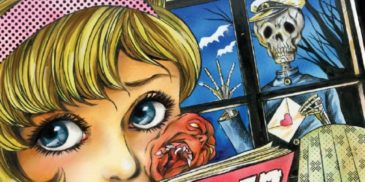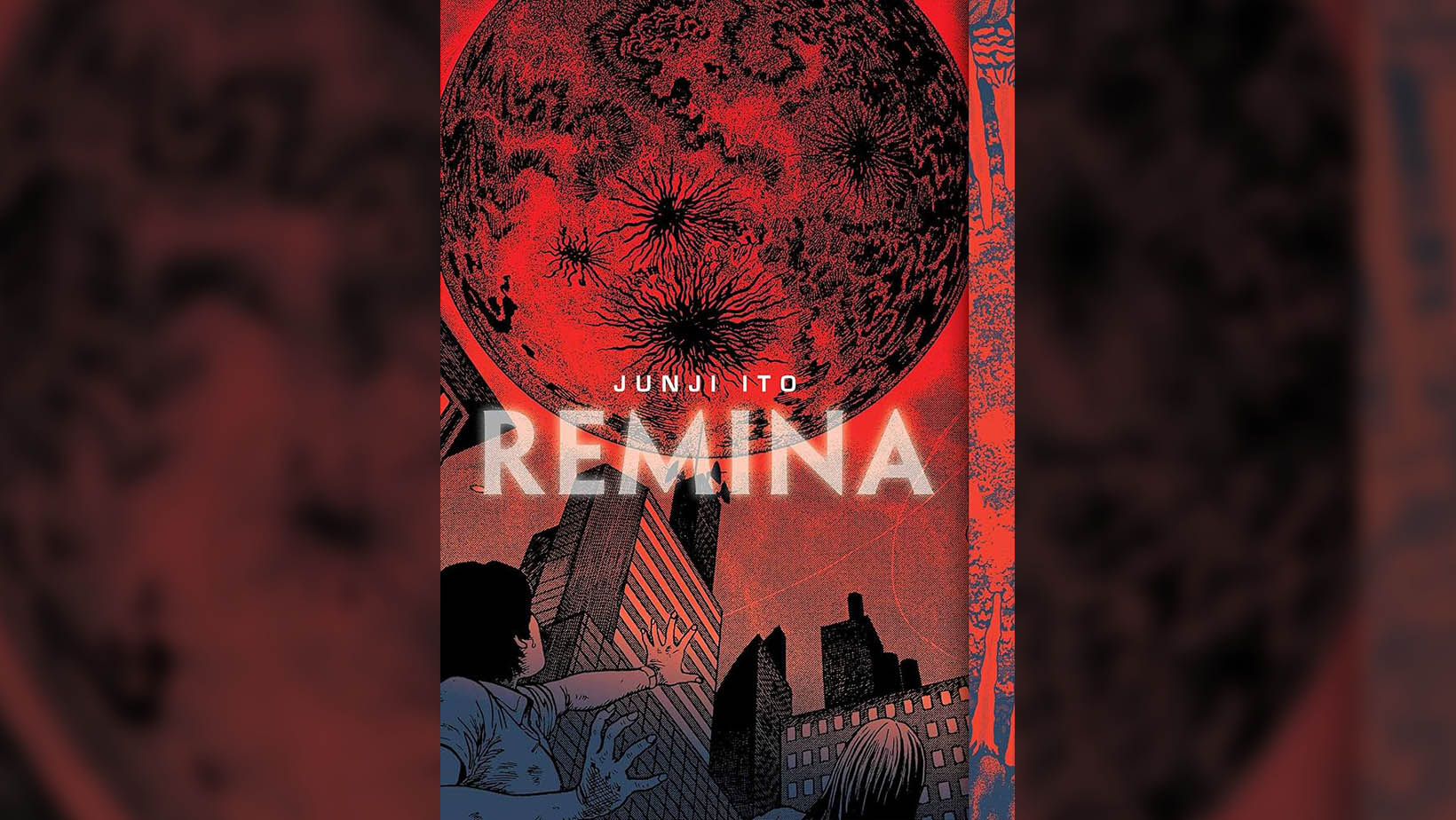
Hello, spookies! Today I’m going to review Hellstar Remina from VIZ. You can purchase it at Amazon. I get no kickbacks from links, but I want to encourage people to get published copies of the works I discuss so that way we can get more content. I’m really hoping that Viz will release Mimi’s Ghost Stories by Junji Ito because it is my favorite. Also, there might be spoilers in this article, so if you want to read this without spoilers then come back and check this review out after you’ve had a chance to read the story.
That said, let’s jump right into Remina. This is the first thing we have to talk about, the title. Viz chose to reduce the name to Remina. I’m not sure why they made this decision but they did abridge it from Hellstar Remina to just Remina. They gave us this brilliant red cover, which is just terribly foreboding. We can see people on the cover being overshadowed by this massive red monster in the sky. And that little bit of blue detail at the bottom showing the shadowing is just beautifully done.
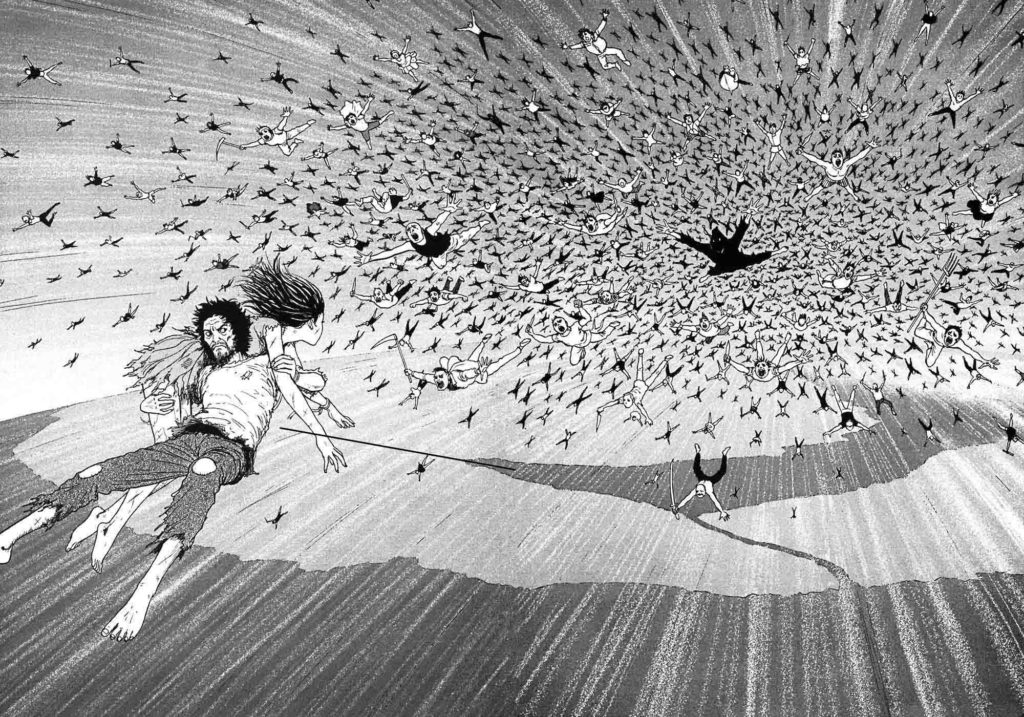
Even the back of the book is beautifully done. It is all blackened out except for the piercing red eyes of Remina. In the far corner are dead bodies, which upon closer inspection show an astronaut’s suit with the helmet blown out. Something very violent happened to these astronauts. Already we can tell we are in for a dark descent into the void.
I think the cover of this book is absolutely beautiful. I love the use of red because we are programmed both socially and naturally to be on the alert with red coloring. Red is the color of blood, it is the color that indicates we must stop, it is the color of fire, of fire alarms, and it indicates danger when in the form of a flashing red light. Viz set us up with a cover that is not only catching but should trigger in us a subconscious alert that something bad is coming.
Now lets get into the meat and potatoes of this book. It starts off with the discovery of a new planet. Seems innocuous enough. Scientists find new celestial bodies all the time, no big whoop, right? And so most people think. They care less about the fact that this planet was found, and more about the fact that Professor Oguro has named it after his beautiful daughter Remina. This simple act of honoring his daughter by sharing her name with the newly discovered planet launches Remina into a world of fame. Everyone loves her, wants to take photos with her, and she, as a humble unassuming normal girl, really grapples with this newfound fame. At least for a brief time.
Even with the fame she does have, she is the perfect idol. In many ways, she reminds me of Mima from Perfect Blue (if you haven’t seen Perfect Blue, you should go watch it, like right away). Mima and Remina both have this demure stature that says “Thank you for the fame, but I am not sure I want it.” Though Mima wanted her fame. She was a pop idol after all. The story does not let us bask in Remina’s new found fame because Ito hustles this story right along. Within the first 40 pages, we discover the planet, get Remina famous, and find out that the planet is rocketing toward us destroying everything in its path.
For some reason, I’m not sure why, the people believe the Oguros are calling the planet to Earth. This starts as a conspiracy theory that someone just thinks up on the street. The idea catches amongst the population and within just a few panels people are calling for the death of the Oguros. Before 2020, before the COVID-19 pandemic, I would have found this idea absolutely absurd. But with the rise of fake news and a ton of conspiracy theories I kind of have to humble myself to the nightmare that is about to ensue. It no longer seems like just fantastic fear taking over the population. No, I could believe that this would happen if this scenario were to play out at the end of 2020.
And like something rising out of the Stephen King’s The Mist an eldritch horror of Lovecraftian proportions makes its hideous self known. And it does so in this glorious two-page spread.
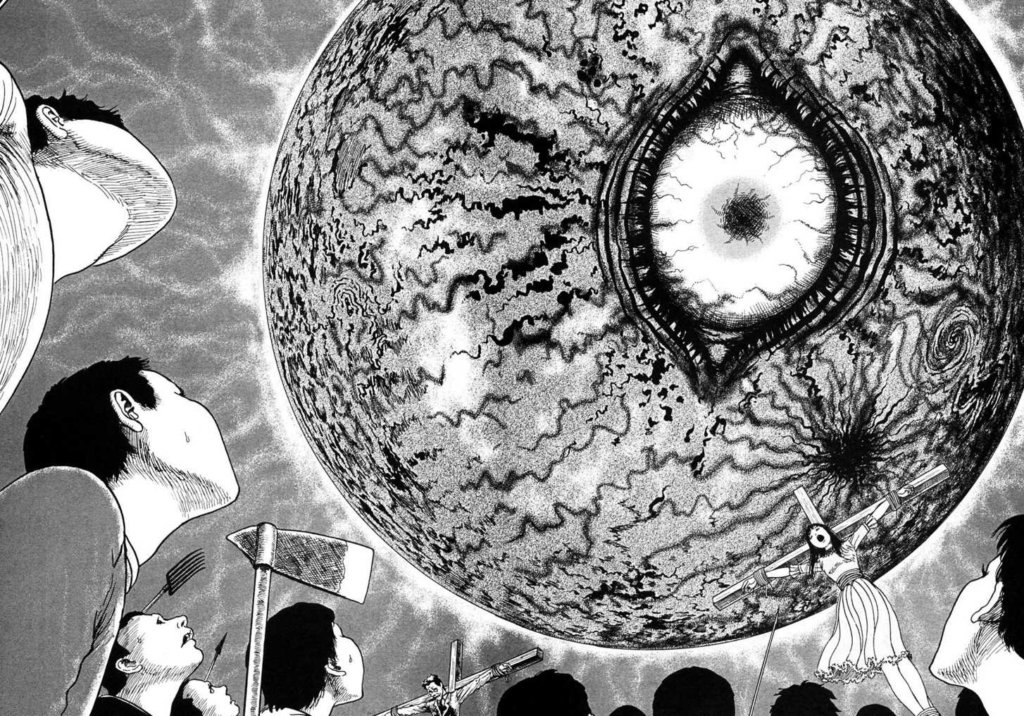
This is the first glimpse of Remina’s eye that humanity gets. We know that one of Dr. Oguro’s assistants saw this monsters eye, and he appeared to go insane. This is very Lovecraftian, and as a D&D gamer myself who has dappled in Lovecraft horror, I am aware of what happens when a God looks at you or touches you. Madness is the name of the game- roll the dice. Remina is no exception.
What I find absolutely poignant about this moment is that humans do what humans do. They reject that this is an eye. How could that be possible? The insanity! It must be a volcano. As a defensive mechanism, humans will reject what they do not understand. And our brains try to replace it with things we do. So this must be a volcano. For me, this was a moment of pure human psychology. The humans aboard the spaceship are trying so hard to rationalize and justify this monster they are seeing, and it is the most human moment of the book.
There is a moment, a few panels later where I think the translators did an excellent job, the people in Tokyo are panicking. This monster is growing before their eyes, getting bigger and bigger and someone in the crowd says “The man who discovered it, Professor Oguro! And his daughter, the star Remina.” I had to put the book down for a moment because that line was poetry to me. Not only do we have this killer monster star in the sky named Remina, but they also reference the fame of Remina the human. And I just love the juxtaposition that was created. I am unsure if that is just good translation on the part of Jocelyne Allen who translated from Japanese to English, or if that was some localization- either way, that was a moment that required me to take pause of the care that went into crafting this story.
As we go deeper into the story I start to see parallels to the pandemic. Perhaps this book was released at just the right time for English-speaking audiences but for American readers specifically. We live in a world where the media is no longer trusted, no one trusts the scientists, and anyone with a loud enough mouth and a crazy enough conspiracy can get national attention. There is a scene in the story where the scientists are gathered together trying to figure out what is going on, and how to stop it and the rumors that are spreading around the globe get brought up. And one man has the audacity to ask if Professor Oguro is calling Hellstar Remina to Earth. I literally rolled my eyes and sighed. It’s too real, y’all, It’s too real.
This book goes in some really dark directions, but one direction it gets really dark, at least in my opinion, is the crucifixion scenes. Crucifixion was a common form of punishment for people during the Edo period (Satore, 2020). So while this feels like it might be borrowing from Christianity I think it is drawing from Japan’s own use of the execution. There is a lot of history throughout the world of crucifixions. Having grown up in a Christian country the crucifixions always have a bit of a religious feel for me. And I can’t completely shut that out when I see them depicted- even after having spent 15 years studying Japanese history. (If you want to go down a really bizarre rabbit hole, you should look up the theory that Jesus did not in fact die on the cross but escaped and went to Japan. There is even a burial site for Jesus in Aomori prefecture. If you go down that hole, I wish you the best.)
As an aside, in Japan sometimes crucifixions were done when the tide was low. They would set the crosses up on the beach when the tide was low. As the tide came in it would slowly drown the person. The pressure from the water crashing into their chests made it hard for them to breathe. This was known as mizuharaitsuke. Sometimes people were crucified upside down- sakasa haraitsuke (Gutenburg, 2002). I don’t think there is a good way to be crucified, but in Japan, people would be strung up and then stabbed repeatedly in the sides. When the punishment had been sufficient the killing blow of a thrust to the throat was carried out. In Remina, we see this very thing play out, and I think it is terribly uncomfortable and makes for some really visceral horror.
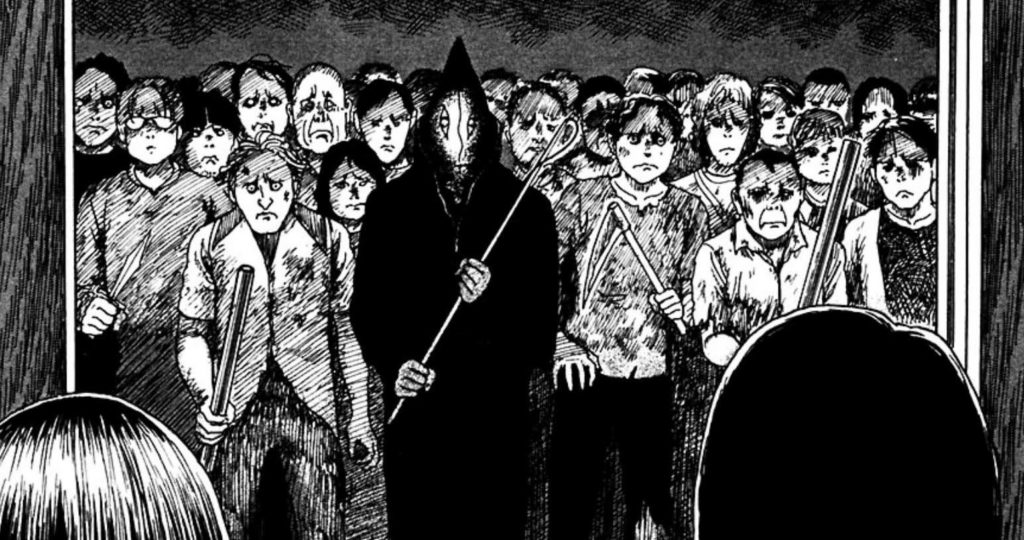
One thing I think is interesting about this story is that the more ugly humanity becomes the more the Hellstar consumes. It’s an allegory, I think, for the monstrous way that humans treat each other and the planet. Maybe Remina always had Earth in its sights and this would have happened no matter what, but maybe it would have just gone right past us. It didn’t speed up in its consumption of the planets until the humans started panicking en masse.
There is also a really horrifying angle that has to be considered. We, humans, are the only species that we know who experienced this planet destroy us. The other planets in our solar system that were consumed did not have species living on them. Even Mars, which has water and bacteria, does not have the same level of conscious life that Earth does. We are the only people who can tell the universe what this planet does. But is there anyone to tell?
In some ways, this reminds me of Stephen King’s The Langoliers. The langoliers are time gods – maybe demons. They eat time, specifically, they eat the past. They destroy what was because we can never go back. They exist for destruction. Remina also exists for destruction. But instead of the past Remina consumes the future. Like the Langoliers, there is nothing left when the Hellstar is done.
Ito doesn’t cease to please with this. It has his signature body horror elements creeping in at the end. There is a horror that I think might be primal that slithers in a the end. As Remina and the few survivors from Earth hurdle through space there is nothing around them. There is nothing when they look out the window except the dark expanse of space. And if this year has proven anything, it is that people do not do well when locked in a space for an extended period of time. It plays on the fear that there is no where we can go and nothing we can do except wait to die.
Junji Ito has crafted a wonderfully horrific experience. And I hope you all enjoy it. Remina is a story that stays in the back of your mind and tickles your brain long after you read it.
Remina by Junji Ito is available to purchase where books are sold
This article was originally published on Kaidan Life
Gutenberg, P. (2002). Crucified. Retrieved December 20, 2020, from http://self.gutenberg.org/articles/Crucified?View=embedded
Ito, J. (2020). REMINA. San Francisco, CA: VIZ MEDIA.
Sartore, M. (2020). The Horrifying, Little-Known History of Japanese Crucifixion. Retrieved December 20, 2020, from https://www.ranker.com/list/history-of-japanese-crucifixion/melissa-sartore
More Manga Reviews:
Soil Manga Review – Tainted Ground Invites Cosmic Horror
Soil is a title I have been familiar with for some time, existing as a cult title that had yet to be published in English. Consequently, I had been tempted…
Obscure Horror Manga – The Disturbed Visions of Noroi Michiru
Horror manga has seen a steady surge in popularity with the likes of Junji Ito, making it to international recognition and closing the gap of mainstream versus the underground. To…
Sagawa-san (2000) Manga – True Crime Manga Written by the Killer
Many people may be aware of the name Issei Sagawa as well as the sickening crime he committed in France, in 1981 but many may not be aware of Sagawa’s…
Puella Magi Suzune ☆ Magica Manga Review – A Dark Yet Captivating Journey into Despair
Puella Magi Suzune Magica is a 3-volume dark fantasy/psychological thriller manga, with the original story written by Magica Quartet and illustrated by GAN. Magica Quartet is a collaborative group consisting…
The Illustrated Guide to Monster Girls: Vol. 1 Manga Review – Kawaii Horror
The Illustrated Guide to Monster Girls is a 4-volume, light-hearted horror/slice-of-life manga, written and illustrated by Suzu Akeko. A prolific manga creator, she has previously written and illustrated Nightmare Eater,…
Wonder House of Horrors (2023) Manga Review – So Cute Yet So Horrific
Collecting 10 stories of the macabre from Miyako Cojima, Wonder House of Horrors marks an impressive introduction of the mangaka to the West. Across the varied stories, Cojima distorts the…
Hello spookies! My name is Liz, and I’m a bit of an academic. I’m here to bring you some academia with your horror. I have several degrees including English Literature with a focus on the horror genera, Japanese language, Japanese literature, and Japanese history. I used to live in Saitama prefecture, Sakura Ku, and attended Saitama University. I also went to Kobe Women’s College and studied Japanese food pathways. In high school I attended Shijonawate Gakkuen in Osaka. I’ve spent the last 15 years watching, critiquing and mostly enjoying Japanese horror media and am an active contributor to the Kwaidan Klub on Facebook. When I’m not working a COVID unit, I like to spend my time at anime conventions doing cultural panels and presentations. My most popular panel to date was a Tokyo Ghost Walk where I walked my panel attendess through some of the most haunted sites and neighborhoods in Tokyo that I got to haunt. So find your seats because class is in session! 🙂
